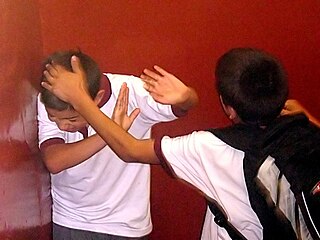Statistics
This section may be confusing or unclear to readers. In particular, the statistics should clearly state whether they are global or particular to the U.S. This article should be global, not U.S.-only..(February 2019) |
Age groups
Bullying is most often found in children and adolescents. In Erick Erickson's stages of psychosocial development, stage five, "identity verses role confusion." Occurs during the teenage ages of 12 to 18.[ citation needed ] This stage depends on the achievement of fidelity in a social group. Leading to stronger sense of identity from the interactions of that social group. Bullying may disrupt the individual's success in creating meaningful relationships in a social group. Insecurity is common in this process of finding an identity. Thus, leading to confusion. A bullied victim in this stage will struggle upon being rejected by their peers and loss of self if none another group is established in this individual's life. Also, the victim may fall short of seeking more social interactions. That will aid in the process of suicide. [12]
Prevention of suicide from bullying for children and adolescents can be alleviated from the support of parents. Being engaged in the child's life. Such as, daily activities, school, or work. Being aware of the child's friends. Changes in the child's life. Such as, lowered grades, physical bruises, or scars, eating and sleeping habits. Sharing personal social experiences, may lead the child to be open in their social experiences. These can help a child suffering from bullying. [7]
In 2010, the suicides of teenagers in the United States who were bullied because they were gay or perceived to be [13] [14] led to the establishment of the It Gets Better project by Dan Savage. [15] [16] The online event, Spirit Day, was created in which participants were asked to wear purple as a symbol of respect for the deceased victims of bullying, particularly cyberbullying, and to signify opposition to the bullying of the LGBT community.
The Centers for Disease Control (CDC) states that almost 45,000 deaths occur from suicide each year. There are about 100 non-fatal suicide attempts to every 1 suicide. A little over 14% of students in high school consider suicide and approximately 7% of them attempt suicide. Students that are bullied are around 2 to 9 times more likely to consider suicide than non-victims. [17] A study in Britain found that at least half of suicides among young people are related to bullying. 10 to 14 year old teen girls are most likely to commit suicide based on this study. According to ABC News, nearly 30% of students are either victims of bullies or bullies themselves and 160,000 kids stay home from school every day because they are scared of being bullied. [18]
Cyberbullying
Cyberbullying is a form of aggression by using the internet and/or electronic communication, such as mobile phones, e-mail, and text message, to cause humiliation, terrorization, embarrassment, and/or psychological distress to a peer. [19] In comparison to verbal bullying, a research study showed that adolescents who reported cyberbullying were 11.5 times more likely to have suicidal ideation, while those who have reported verbal bullying were only 8.4 times more likely. [20] In another study, 75% of adolescents who experienced cyberbullying presented with higher suicidal ideation than those who have experienced verbal bullying. [21] Furthermore, cyberbullying is becoming more prevalent and reoccurring than normal bullying in today's society with the increase in ownership of technology throughout the world. Cyberbullying in ways is worse than regular bullying since in a sense it does not have to stop since social media can follow you wherever you go and the bully in question can be harder to contain, which results in more consistent and harsher bullying between two parties. Lastly as the constant cyberbullying continues it can cause the victim to experience an array of emotions like anger, sadness, and loneliness which can lead to their state of mind completely changing that typically include anxiety and depressive habits. As this state of minds get worse it can even cause the victim to commit suicide. [22]
Amanda Michelle Todd was a victim of cyberbullying and committed suicide. On October 19, 2012, at the age of 15, from British Columbia, Canada. She posted a video on YouTube, sharing her story of being stalked, used, being bullied at school and by online comments. Her story escalated when the online comments, cyberbullying, told her that she should have used another bleach to kill herself. This lead Todd to hang herself, not long after. [23]
As of 2022, research has come to show that perpetrators of cyberbullying often report having a history of being bullied themselves, and their rates of suicidality are similar to those who are victims of cyberbullying. [24]
Lesbian, Gay, Bisexual, Transgender (LGBTQ+) Youth
US lesbian, gay, and bisexual students attempt suicide 2–7 times more than heterosexuals and up to one third of transgender people has made an attempt on their life. [25] Young adults of the LGBT community "must cope with developing sexual minority identity along with negative comments, jokes, and threats of violence". [26] A research identified that 19 studies were linked to suicidal behavior in lesbian, gay, and bisexual (LGB) students to bullying at school. Lesbian, Gay, Bisexual, and Transgender students experience more bullying than heterosexual or cisgender students. [27]







